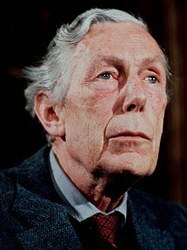Anthony Blunt
Anthony Blunt was a revered art historian who was uncovered as a former Soviet spy in 1979. Blunt was a member of the ‘Cambridge Five’ spy ring during World War Two. He turned his back on communism after the war and became a pillar of the establishment. Blunt worked as Surveyor of the King’s (and later Queen’s after Elizabeth II’s accession to the throne) Pictures for 27 years and was made a Knight Commander of the Royal Victorian Order in 1956. After Margaret Thatcher gave him the title ‘Fourth Man’, Blunt was hounded by the press and stripped of his knighthood. He died of a heart attack in 1983 at the age of 75.
Anthony Blunt was born on 26 September 1907 in Bournemouth, Hampshire. He was educated at Marlborough College and Trinity College Cambridge, where he studied mathematics and Modern Languages and was a member of the Cambridge Apostles. He graduated in 1930 and became a Fellow of Trinity in 1932.
It is not clear when exactly Blunt became a Soviet spy. Blunt claimed that Guy Burgess had recruited him after they had left Cambridge. However, it is also possible that Blunt recruited Burgess.

Blunt became a member of the British Army in 1939 and was recruited a year later by MI5. Blunt was thought to be a communist sympathiser but he was not seen as an actual threat. During the war, Blunt passed on sensitive information to the USSR. He ended the war with the rank of major.
After World War Two, King George VI gave Blunt the prestigious role of Surveyor of the King’s Art. In 1947 he stepped into the role of director at the Courtauld Institute of Art and Professor of History of Art at the University of London. He was the Courtauld’s director for 27 years and taught some of the most influential art historians today, including the art critic Brian Sewell and Neil Macgregor, director of the British Museum.
After Guy Burgess, Blunt’s friend, defected with Donald Maclean to the USSR 1951, Blunt became a suspect. Blunt was repeatedly interviewed by MI5 but did not break. In 1956, Blunt was knighted by Elizabeth II.
The MI5 finally found proof of Blunt’s spying in 1963. The information came from the FBI. Michael Straight, a former Soviet spy, had made a confession to the FBI. He named Blunt, who confessed on 23 April 1964. He was granted immunity from prosecution and his confession remained a secret. Blunt was able to keep his knighthood and continued as Surveyor of the Queen’s Pictures until 1973, even after Queen Elizabeth II had been informed of his treachery.
Blunt’s wartime role was finally exposed by Margaret Thatcher in November 1979 when the then Prime Minister admitted that Blunt had been a Soviet spy in the House of Commons. Blunt’s knighthood was annulled.
Blunt subsequently publicly confessed on TV. In a BBC interview broadcast on 20 November 1979, he claimed that his work as a spy was ‘a case of political conscience against loyalty to country’.
Blunt turned into a recluse and focused on writing his memoirs. In his memoirs, which were made public in 2009, he said the following:
"What I did not realise is that I was so naïve politically that I was not justified in committing myself to any political action of this kind. The atmosphere in Cambridge was so intense, the enthusiasm for any anti-fascist activity was so great, that I made the biggest mistake of my life."
Anthony Blunt died of a heart attack on 26 March 1983, at the age of 75.
See also: Guy Burgess
MLA Citation/Reference
"Anthony Blunt". HistoryLearning.com. 2025. Web.
Key facts
| Name: | Anthony Frederick Blunt |
| Birth Date: | 26 September 1907, Bournemouth, Hampshire,England, UK |
| Death: | 26 March 1983 (aged 75), Westminster, London |
| Nationality:/td> | British |
| Education: |
|
| Select Publications |
|
